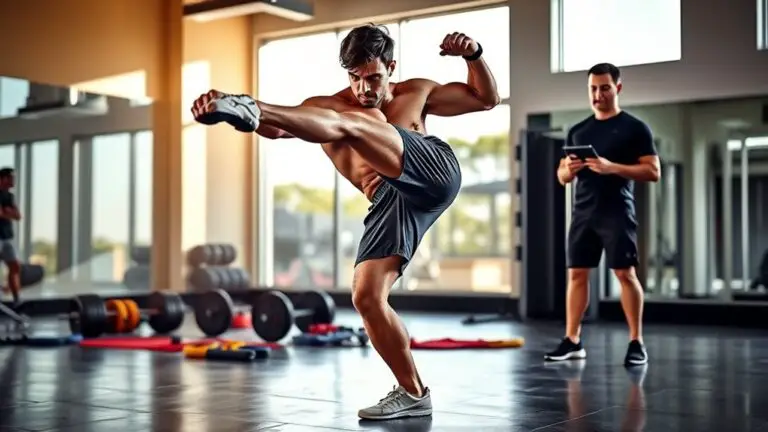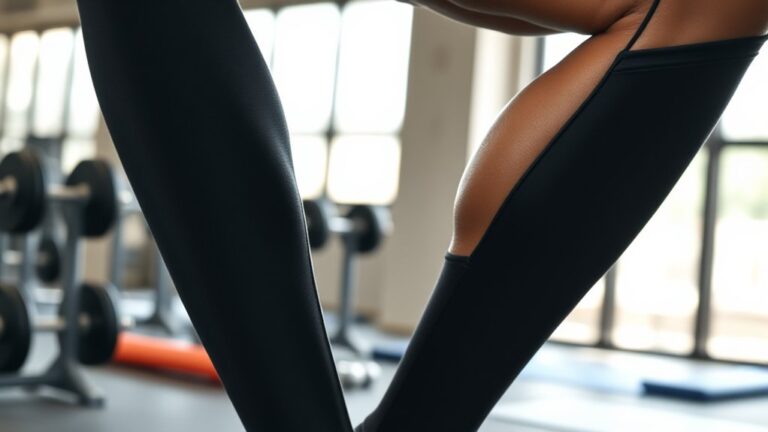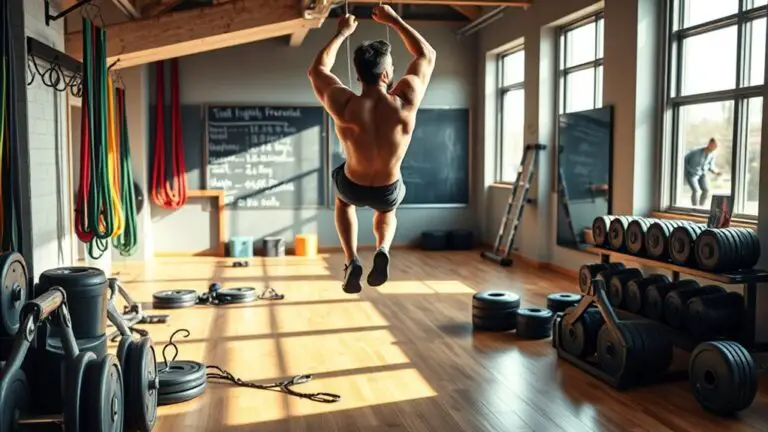How to Improve Hip Mobility for Squats and Deadlifts
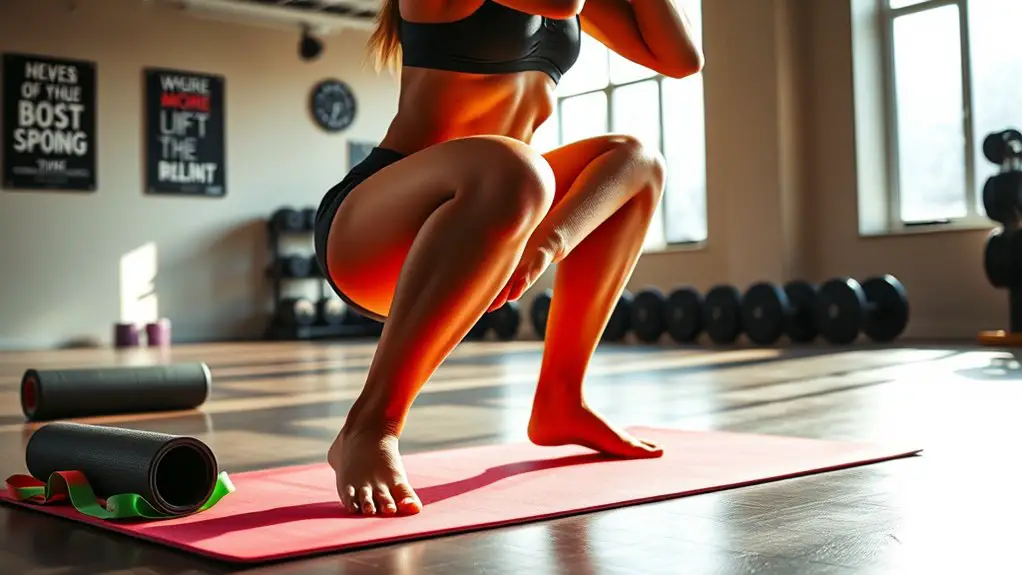
To improve hip mobility for squats and deadlifts, focus on dynamic warm-ups like leg swings and hip circles. Incorporating targeted stretches, such as the pigeon pose and hip flexor stretch, is essential for flexibility. Strengthening exercises like glute bridges and single-leg deadlifts will add stability. It’s important to monitor your progress and adjust your routine based on mobility assessments. Stay committed, and you’ll reveal greater lifting potential. Discover more effective techniques ahead!
Understanding the Importance of Hip Mobility

When you think about improving your squat and deadlift performance, you can’t overlook the role of hip mobility. Your hip joint anatomy plays a vital role in these lifts, allowing for ideal range of motion and stability. A well-functioning hip joint guarantees that your body can effectively transfer force from your lower body to the barbell.
Incorporating functional movement analysis can help you identify specific mobility deficits. This assessment provides insight into how your hips move and interact with other body parts during squats and deadlifts. By understanding these mechanics, you’ll recognize the importance of maintaining and improving hip mobility.
Investing time in mobility work not only enhances your performance but also reduces the risk of injury. So, prioritize hip mobility in your training routine, and watch as your squat and deadlift numbers soar. Your hips are the foundation; strengthen them for greater gains!
Common Causes of Tight Hips
Tight hips can stem from several common factors that many people overlook, often hindering your performance in squats and deadlifts. One major culprit is a sedentary lifestyle; sitting for prolonged periods can cause your hip flexors to tighten. Additionally, muscle imbalances, often resulting from poor posture, can restrict your range of motion. If you’re pushing too hard without proper recovery, overtraining syndrome might be to blame, leading to further stiffness.
Injury history can also play a role, as past injuries can create compensation patterns that tighten your hips. Repetitive movements in daily activities can exacerbate these issues, creating a cycle of discomfort. Finally, inadequate warm-ups before workouts can prevent your hips from properly preparing for movement. While genetic factors may contribute to your hip mobility, addressing these common causes can greatly enhance your performance and comfort in the gym. Don’t let tight hips hold you back!
Effective Dynamic Warm-Up Exercises
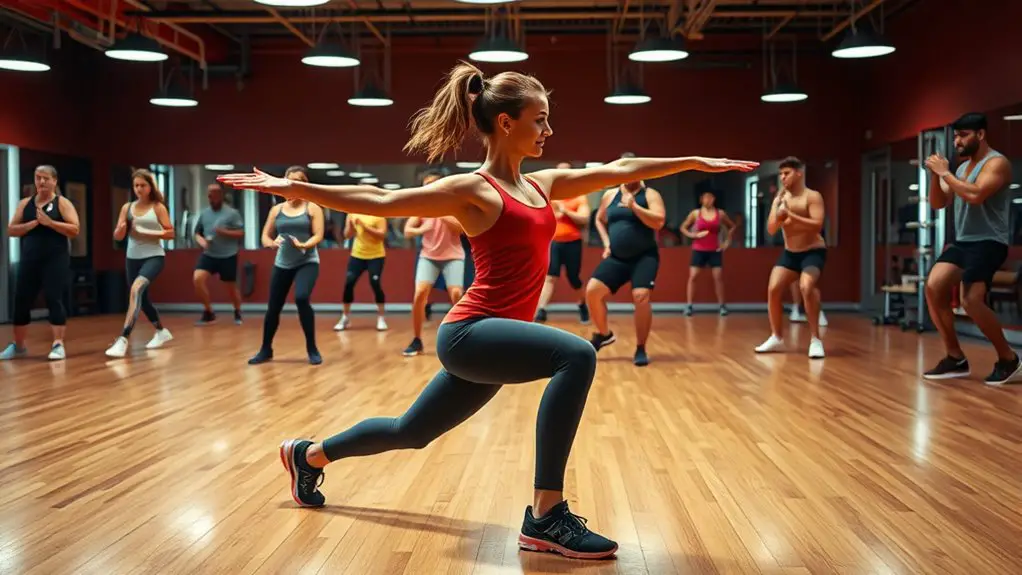
To guarantee your hips are primed for squats and deadlifts, incorporating effective dynamic warm-up exercises is essential. Start with hip circles; stand on one leg and rotate the opposite leg in a circular motion. This not only loosens your hip joints but also improves coordination. Aim for 10-15 circles in each direction.
Next, include leg swings to further enhance mobility. Hold onto a wall or sturdy surface for balance and swing one leg forward and backward. Perform 10-15 swings per leg, focusing on keeping your movements controlled.
These dynamic exercises activate the muscles around your hips, preparing them for the demands of heavier lifts. By committing to this warm-up routine, you’ll not only improve your range of motion but also reduce the risk of injury. So, take the time to warm up; your hips will thank you when you hit those squats and deadlifts!
Key Stretching Techniques for Improved Flexibility
Releasing greater hip mobility involves incorporating key stretching techniques that enhance flexibility and support your squat and deadlift performance. To achieve this, focus on a combination of static stretches and foam rolling. These methods can greatly improve your range of motion and reduce muscle tightness.
Here are some effective techniques to take into account:
- Hip Flexor Stretch: Kneel on one knee and push your hips forward to stretch the hip flexors.
- Pigeon Pose: Bring one leg in front of you and extend the other behind, opening up the hips.
- Butterfly Stretch: Sit with the soles of your feet together and gently push your knees down to stretch the inner thighs.
- Foam Rolling: Target the hip and glute areas to release tension and improve blood flow.
Incorporating these techniques into your routine will prepare your hips for ideal performance in squats and deadlifts.
Strengthening Exercises to Support Hip Mobility
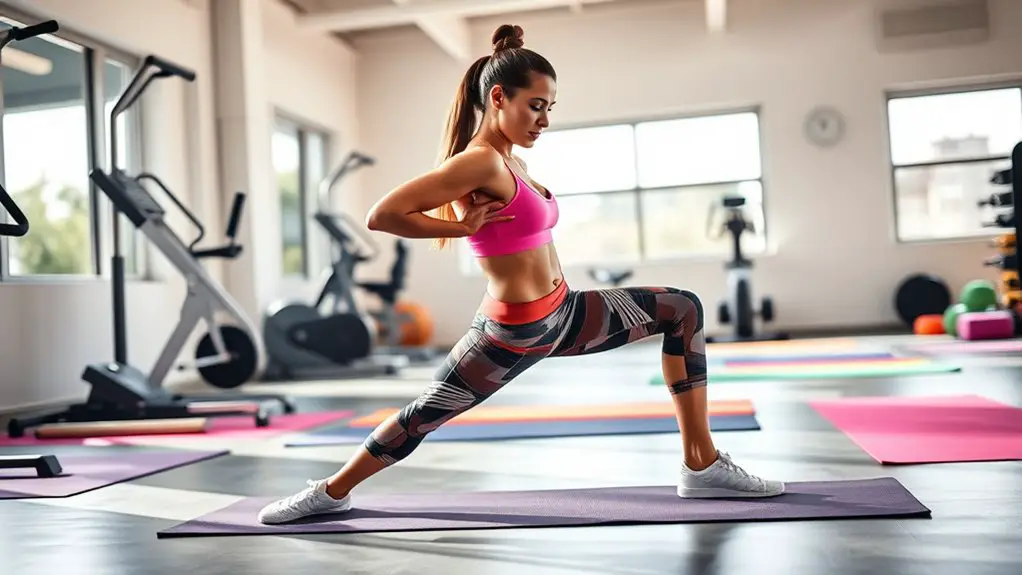
To enhance your hip mobility for squats and deadlifts, incorporating strengthening exercises is essential. Key movements, resistance band exercises, and bodyweight mobility drills can greatly support your progress. By integrating these into your routine, you’ll build the strength needed for better mobility and performance.
Key Strengthening Movements
Incorporating key strengthening movements into your routine can greatly enhance hip mobility, making squats and deadlifts more effective and safer. These exercises not only improve your strength but also promote mobility enhancement, allowing for better performance and reduced injury risk. Here are some essential movements to include:
- Glute Bridges: Activate and strengthen your glutes, vital for hip stability.
- Hip Thrusts: Elevate your hips to increase power and mobility in the hip flexors.
- Squat Variations: Try goblet or front squats to engage your hips differently.
- Single-Leg Deadlifts: Enhance balance and unilateral strength, targeting each hip individually.
Resistance Band Exercises
Resistance band exercises are a fantastic way to enhance hip mobility while building strength. Incorporating movements like band pull aparts can greatly improve your upper back stability, which is essential for maintaining proper squat and deadlift form. As you perform band pull aparts, focus on keeping your shoulder blades down and back, allowing your hips to stay in a strong, stable position.
Additionally, lateral band walks target the hip abductor muscles, promoting stability and mobility. By stepping side to side with a resistance band around your legs, you’ll activate those vital muscles that support your knees and hips. Regularly including these exercises in your routine can lead to significant improvements in your overall hip mobility, making your squats and deadlifts more effective and safer.
Bodyweight Mobility Drills
While mobility is often associated with flexibility, strengthening your muscles is equally essential for improving hip mobility, especially for activities like squats and deadlifts. Incorporating bodyweight mobility drills into your routine can enhance your strength and stability. Here are some effective exercises to try:
- Bodyweight Lunges: Engage your quads and glutes while stretching your hip flexors.
- Hip Circles: Improve joint range of motion by rotating your hips in both directions.
- Squat to Stand: Open up your hips and lower back while strengthening your legs.
- Cossack Squats: Challenge your lateral movement and flexibility.
Integrating these drills into your workouts will not only support your hip mobility but also elevate your performance in squats and deadlifts.
Incorporating Mobility Work Into Your Routine
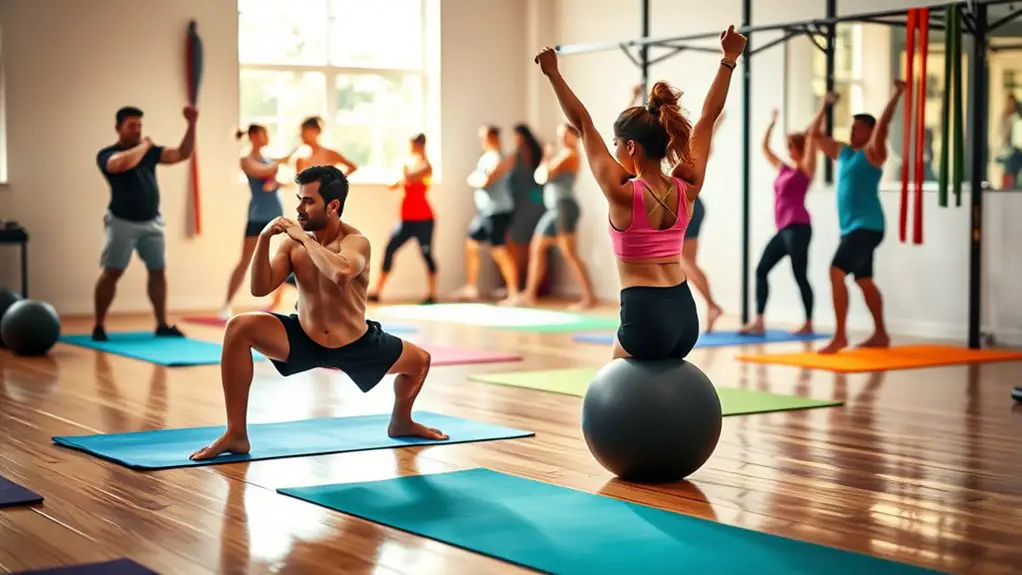
Incorporating mobility work into your routine is essential for enhancing your squat and deadlift performance. Start with dynamic warm-up exercises to prime your hips and prepare your body for movement, followed by targeted stretching techniques to increase flexibility. By making these practices a regular part of your training, you’ll notice significant improvements in your overall strength and mobility.
Dynamic Warm-Up Exercises
Kickstart your workout routine with dynamic warm-up exercises that target hip mobility, setting the stage for effective squats and deadlifts. Incorporating mobility routines into your pre-workout regimen can enhance your performance and reduce injury risk. Here are some key dynamic stretching exercises to contemplate:
- Leg Swings: Forward and sideways swings to loosen the hip joints.
- Walking Lunges: Engage your hip flexors while promoting stability.
- Hip Circles: Rotate your hips to improve joint fluidity and range.
- Knee Hugs: Pull your knees to your chest to activate your glutes and hip flexors.
Stretching Techniques Overview
Many athletes overlook the importance of stretching techniques, yet incorporating targeted mobility work into your routine can greatly enhance your performance in squats and deadlifts. To maximize your hip mobility, start with mobility assessments to identify your specific limitations. This’ll help you focus on areas needing improvement. Static stretching is a powerful tool in this process, allowing your muscles to relax and lengthen, ultimately increasing your range of motion. Aim to include static stretches after your workouts for best results. Remember, consistency is key. By regularly incorporating these stretching techniques, you’ll not only improve your mobility but also reduce the risk of injury. Stay committed, and watch how your squats and deadlifts transform!
Monitoring Progress and Adjusting Your Approach
As you work on improving your hip mobility for squats and deadlifts, monitoring your progress is essential for ensuring you’re on the right track. Regular progress tracking allows you to see what’s working and what needs adjustment in your approach. Here are some effective ways to monitor and adjust:
- Keep a Journal: Document your exercises, stretches, and how your hips feel after each session.
- Use a Foam Roller: Track your flexibility improvements by measuring how far you can roll over tight areas.
- Record Your Workouts: Video your squats and deadlifts to analyze your form and identify mobility issues.
- Set Specific Goals: Establish milestones, like achieving a deeper squat or easier deadlift, to motivate your journey.
With this structured approach, you can make informed adjustments to your training, ensuring continual improvement in your hip mobility. Keep pushing forward!
Frequently Asked Questions
Can Poor Hip Mobility Lead to Injuries During Exercise?
Absolutely, poor hip mobility can lead to injuries during exercise. When your hips aren’t moving efficiently, other joints compensate, increasing injury risk. This lack of movement efficiency not only hampers your performance but also puts unnecessary stress on your body. By prioritizing injury prevention through proper mobility training, you can enhance your overall performance and keep yourself safe. Remember, investing time in mobility now will pay off in your future workouts!
How Long Does It Take to See Improvements in Hip Mobility?
It typically takes a few weeks to see improvements in hip flexibility if you’re consistent with mobility exercises. Everyone’s body is different, but with regular practice, you’ll likely notice increased range of motion and reduced tightness. Focus on incorporating a variety of stretches and movements into your routine, and remember that patience is key. Stay motivated, and you’ll reveal the benefits of better hip mobility in no time!
Is Hip Mobility Training Suitable for Beginners?
Think of hip mobility training as a key to revealing your body’s potential. Yes, it’s absolutely suitable for beginners! Starting with beginner techniques and basic mobility exercises can set the foundation for your fitness journey. These exercises are designed to be gentle yet effective, helping you enhance your range of motion without risking injury. So don’t hesitate; embrace hip mobility training, and you’ll pave the way for improved performance and overall well-being!
What Role Does Nutrition Play in Hip Mobility?
Nutrition plays an essential role in hip mobility. When you incorporate anti-inflammatory foods like leafy greens, berries, and fatty fish into your diet, you can help reduce inflammation and maintain joint health. Nutritional supplements such as omega-3 fatty acids and vitamin D can further support mobility. Remember, fueling your body with the right nutrients not only enhances your performance but also promotes recovery, allowing you to move more freely and effectively.
Can Yoga Improve Hip Mobility for Weightlifting?
When it comes to improving hip mobility for weightlifting, you’ve hit the nail on the head with yoga. Certain yoga poses, like pigeon and butterfly, can greatly enhance your flexibility benefits. They stretch and strengthen the hip muscles, allowing for better range of motion. Incorporating these poses into your routine can make a world of difference. So, grab your mat and start practicing—your lifts will thank you for it!



